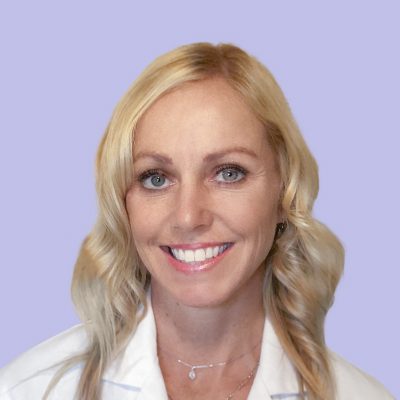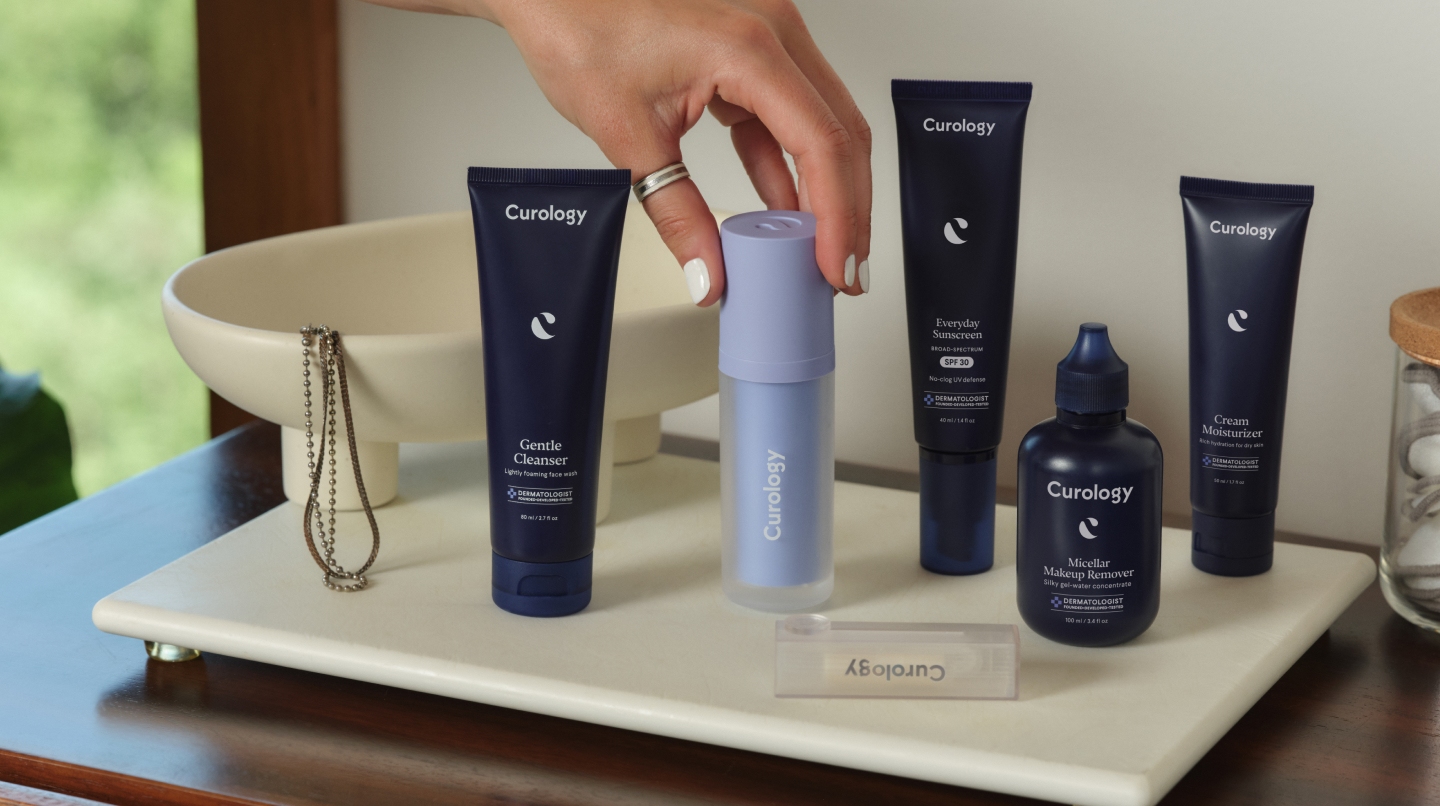How it works:
Share your skin goals and snap selfies
Your dermatology provider prescribes your formula
Apply nightly for happy, healthy skin
How it works:
How it works:
Share your skin goals and snap selfies
Your dermatology provider prescribes your formula
Apply nightly for happy, healthy skin
How it works:
Neck acne: Causes and effective treatments
In short, you can generally treat it just like you’d treat face acne—but it can have some differing factors.



Acne breakouts commonly happen on the face, but the truth is they can also pop up in other areas, including the neck. Many factors can contribute to neck acne, including hormonal imbalances, friction from clothing, and sweating. And like acne on your face, there are also different types of neck acne with different ways of treating it. The good news? The same skincare products you use on the face work to treat and prevent breakouts on the neck, too.
What is acne?
Acne is a general term used to describe many types of blemishes that form when excess sebum (the skin’s natural oil) and a build-up of dead skin cells clog hair follicles. When acne-causing bacteria feed on this excess sebum, inflammation, and acne can occur.¹ Non-inflammatory lesions (whiteheads and blackheads) and inflammatory lesions (papules, pustules, nodules, and cysts) are all acne blemishes. Hormones, genetics, stress, pore-clogging (comedogenic) beauty products, and diet can contribute to breakouts.
Types of neck acne
Acne—regardless of the cause—can appear places on the body that have hair follicles (typically the face, neck, shoulders, chest, and back). Hormonal neck acne tends to appear around the lower cheeks, jawline, and upper neck area. Here are the basics about each type:
Whiteheads are non-inflammatory closed comedones that consist of plugged follicles.
Blackheads are non-inflammatory open comedones open to the skin’s surface.
Pustules are red bumps filled with white or yellow pus. They’re inflamed, tender, and often painful.
Papules may appear in clusters—they’re what most people think of when they hear the word “pimple.” Papules are pink or red bumps that don’t have pus or a head. Like pustules, they can be painful.
Nodules are deeper bumps that form beneath the skin’s surface. They’re hard and often painful.
Cystic acne on the neck is a more severe form of inflamed acne. The lesions may be filled with pus, often painful, and can lead to acne scars.
Three contributing factors to neck acne
When combating acne, step one is to figure out what’s causing it in the first place (acne face mapping can help). The neck is unique in that many contributing factors, like friction from clothing, sweating, and shaving can increase the likelihood of a breakout. Here’s a closer look at those three:
Friction from clothing or accessories can lead to breakouts on the neck. Certain fabric types lend themselves to unfavorable neck acne, including synthetic, non-breathable fabrics (polyester and neoprene). Restrictive clothing and accessories (even things like the strap of your bike helmet) cause friction, which rubs on the skin, potentially leading to irritated skin and acne.
Excessive sweating from working out can increase your chances of breakouts.² The moisture produced from sweating creates a bacteria-loving microclimate that can contribute to acne. You can reduce your chances of breaking out after working out by changing out workout clothes and rinsing off with warm water.
Shaving can also contribute to breakouts—but it can be the shaving cream you use rather than the shaving. Many shaving creams have pore-clogging ingredients or ingredients that irritate sensitive skin. Shaving can also lead to ingrown hairs and razor bumps, which may appear similar to acne but are different.
How to get rid of neck acne
The good news is the same acne-fighting ingredients in facial skincare also work for your neck and déclloté. If you’re struggling with back or body acne, however, you might need something different (that said, a lot of the same options can be used here, too!).
Consistent skin care helps get rid of acne and helps prevent it from occurring. Below are some popular neck acne treatment options. Some products are available over the counter (OTC), and others by prescription.
Benzoyl peroxide is a popular OTC treatment that kills acne-causing bacteria that contribute to inflammatory acne.³ Benzoyl peroxide is available in facial cleansers and in leave-on topical treatments. You may want to try Curology’s Acne Cleanser with 2.5% benzoyl peroxide. It treats and helps prevent acne while still being gentle enough for daily use.
Salicylic acid is another OTC ingredient common in facial cleansers. It’s a chemical exfoliant that penetrates deep into the skin to help clear dead skin cells and sebum from pores. It’s proven to help treat and prevent acne.⁴
Topical retinoids such as adapalene, tretinoin (considered by many to be the gold standard in topical acne treatment), and tazarotene are available with a prescription from a dermatology provider. Retinoids are available in gel, lotion, or cream form. Adapalene can also be found over the counter.
Oral medications used to treat acne may include contraceptives, isotretinoin, spironolactone, and oral antibiotics such as doxycycline.⁵ Talk with a licensed medical provider about the potential side effects of oral medications to find a solution that’s right for you.
Topical antibiotics. Topical antibiotics are used to treat acne vulgaris. Clindamycin, in particular, treats inflammatory lesions.⁶
At Curology, we use clinically researched ingredients

All skin needs and deserves plenty of TLC, but here at Curology, we believe acne-prone skin deserves a little more. With routine skincare using proven ingredients, like Curology’s Acne Body Wash, it’s possible to treat and help prevent breakouts on the neck.
The ingredients you put on your skin and some simple lifestyle changes can go a long way, which is why Curology uses active ingredients that are clinically researched. Our products are non-comedogenic, dye-free, and paraben-free. You can give them a try when you sign up for Curology.
Ready to get started? Just answer a few questions and snap a few selfies to help us get to know your skin. If Curology is right for you, one of our in-house licensed dermatology providers will recommend a personalized skincare routine, prescribe a personalized formula to help achieve your skin goals, and answer any questions you might have along the way.
FAQs
Consistent skincare helps get rid of acne and helps prevent it from occurring. Below are some popular neck acne treatment options. Some products are available over the counter (OTC), and others by prescription.
Benzoyl peroxide is a popular OTC treatment that kills acne-causing bacteria that contribute to inflammatory acne.
Salicylic acid is another OTC ingredient common in facial cleansers.
Topical retinoids such as adapalene, tretinoin (considered by many to be the gold standard in topical acne treatment), and tazarotene are available with a prescription from a dermatology provider.
Oral medications used to treat acne may include contraceptives, isotretinoin, spironolactone, and oral antibiotics such as doxycycline.
Topical antibiotics. Topical antibiotics are used to treat acne vulgaris. Clindamycin, in particular, treats inflammatory lesions.
P.S. We did the homework so you don’t have to:
Linda K. Oge, et al. Acne Vulgaris: Diagnosis and Treatment. American Family Physician. (2019).
Ayer, J. and Burrows, N. Acne: More than skin deep. Postgraduate Medical Journal. (August 2006).
Kawashima, Makoto et al. Clinical efficacy and safety of benzoyl peroxide for acne vulgaris: Comparison between Japanese and Western patients. The Journal of Dermatology. (November 2017).
MedlinePlus. Salicylic acid topical. (n.d.).
Zaenglein, A. L., et al. Guidelines of care for the management of acne vulgaris. Journal of the American Academy of Dermatology. (2016 May 1).
Lazic Mosler, E., et al. Topical antibiotics for acne. The Cochrane Database of Systematic Reviews, (2018 January 23).
Meredith Hartle is a board-certified Family Medicine physician at Curology. She earned her medical degree at Kirksville College of Osteopathic Medicine in Kirksville, MO.
* Subject to consultation. Subscription is required. Results may vary.

Curology Team

Meredith Hartle, DO
Related Articles
Does dermaplaning cause acne? Experts explainThe 6 best chemical exfoliators for glowing skinNavigating the world of oil-free moisturizers: Our top 4 picksPeptides for skin: Unpacking their skincare influenceSeborrheic dermatitis vs. rosacea: What you need to knowPopular Articles
Ask Curology: Is my cold breaking me out?Slugging: The dermatologist-approved skincare hack going viral on TikTokTretinoin vs retinol: What’s the difference?How to create a self-care routine that actually sticksYour 2023 skincare horoscopeTry prescription skincare
Get routine essentials

Good skin days ahead
- Breakouts
- Redness
- Fine lines
- Dark spots
- Hair thinning